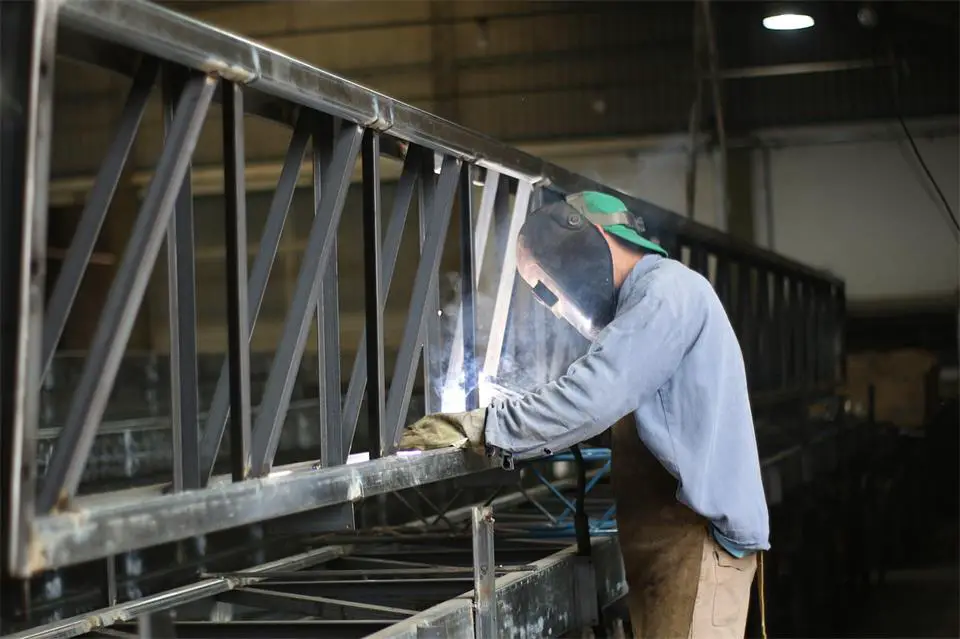Business
What Makes a Welding Supplier Worth Partnering With Long-Term?


What’s the real difference between a decent welding supplier and one you’ll actually want to stick with for years? It’s not just price. It’s not just convenience. And it’s definitely not just about who’s got the fanciest gear on the shelf.
For most welders, the relationship with a supplier goes beyond transactions. It’s about trust, reliability, and backing you when the pressure’s on. So if you’re weighing up whether your current supplier is worth the long haul, or you’re looking to switch, here’s what to actually look for.
They Know the Industry, Not Just the Stock
A good supplier can sell you gear. A great welding supplier WA understands what you do with it. When you mention TIG or MIG, they don’t blink. If you bring up an issue with aluminium warping or stainless fume control, they don’t shrug and pass the problem back to you. They’ve either seen it before or know someone who has—and they’re ready to help.
More than that, they keep up with the trade. Not because it’s trendy, but because it helps them help you. Whether it’s new processes, better PPE standards, or just smarter ways to get jobs done, they’re tuned in. That knowledge filters down to you without you needing to go searching for it.
Consistency Beats Big Promises
Anyone can promise the world when you first sign up. But what happens six months in, when you need something in a hurry? Or when prices go up and stock levels get tight?
Long-term suppliers prove themselves through consistency. They don’t change their tune once they’ve got your business. Orders are accurate, deliveries show up when they say they will, and they give you the same level of service whether you’re spending $200 or $20,000.
They Don’t Just Sell to You – They Support You
Support can mean a few different things, depending on what kind of work you’re doing. But here’s the key: a supplier worth sticking with will offer support that actually matters to your day-to-day.
It might look like:
- Giving clear advice when you’re unsure which wire or rod to go for
- Helping with warranty claims so you’re not chasing manufacturers yourself
- Offering honest input if something you’re asking for isn’t the best fit
Basically, they act like a partner, not a salesperson. And if something goes wrong, they don’t leave you holding the bag.
Fair Pricing (Without the Nasty Surprises)
You’re not expecting rock-bottom prices on everything, but you do expect fairness. A long-term supplier will be transparent about pricing, especially when things change. They won’t quietly bump up costs and hope you don’t notice. And they’ll flag opportunities to save, especially if they know you’re ordering certain items regularly.
Some even offer account perks once you’ve been with them a while, but it’s not about discounts alone—it’s about getting value across the board. From service, delivery, and advice.
Stock Availability That Matches Your Workload
There’s nothing worse than lining up a week’s worth of welding, only to find out you can’t get the gas, wire, or consumables you need.
A strong supplier will have systems in place to keep the essentials ready to go. Even better if they take the time to understand what you use regularly, so they can anticipate stock needs and plan accordingly.
They’re proactive, not reactive. Which makes your life easier and keeps jobs moving.
Real People You Can Actually Reach
You don’t want to sit on hold. You don’t want to be passed around. And you definitely don’t want to explain your situation ten times before getting an answer.
A supplier that’s in it for the long term will make it easy to get in touch with someone who knows your account and understands the trade. No automated maze. No generic replies.
Whether it’s by phone, email, or even a visit to the workshop, if they’re responsive and easy to deal with, it shows they value the relationship, not just the invoice.
They Pay Attention to the Little Things
It might not sound like a big deal, but details matter. Correct invoices. Clearly labelled deliveries. Friendly drivers who know where to drop gear without getting in the way of work. Updates when something’s delayed. Reminders when you’re running low.
These small touches show respect for your time and business. They make the whole experience smoother, with less chasing and fewer headaches on your end. And over time, that adds up.
They Grow With You
Your setup might be simple now. But that could change. Whether you’re bringing on more work, expanding your gear, or shifting into different welding processes, your supplier should be able to scale with you. That means more than having extra product lines; it means understanding how your needs evolve and helping you make smart moves along the way.
The right supplier won’t just meet your current needs, they’ll stay relevant as you grow. That’s a rare quality, and one worth holding onto.
So, Are They Really In It for the Long Haul?
Welding’s not a one-size-fits-all trade. And neither is choosing a supplier. The best ones stick with you through thick and thin. They show up when it counts, keep your workflow steady, and make your job just that little bit easier day after day.
If you’ve got that kind of supplier, look after them. And if you don’t, it might be time to rethink who’s standing in your corner. The difference isn’t always obvious at first. But over time? It shows.
Business
Bottles, Labels, and Magic Machines: How Wine Gets Ready for the World


Wine doesn’t just appear on shelves in glass bottles with perfect labels. Before it gets there, it goes through a lot of behind-the-scenes action. Some of it’s messy, some of it’s high-tech, and all of it is way more important than most people think.
Winemaking doesn’t end when the grapes are crushed and the juice has aged in barrels. There’s a whole second half to the story—and this part is where wine actually gets ready to go out into the world.
Let’s break it down in a way that’s easy to understand, without skipping the cool parts.
The Last Step Isn’t Just a Quick Pour
Once wine has finished fermenting and aging, it doesn’t just get poured into bottles by hand. Sure, that might happen for a few small batches at home, but for real wineries? That would take forever. Instead, wineries use machines—some simple, some really advanced—that clean, fill, seal, and label each bottle.
These machines don’t just make things faster. They make sure every bottle gets the exact same amount of wine, stays clean, and doesn’t spoil later.
This whole system is called bottling and packaging, and it’s kind of like the final exam for a wine. If anything goes wrong here, all the hard work that went into making it can go to waste.
For wineries that want to keep things running smoothly, using dependable wine bottling equipment is a game-changer. It’s not just about speed—it’s about getting it right every time.
Why Bottling Matters More Than You’d Think
Some people assume wine is safe as long as it tastes good before it’s bottled. That’s not true at all. Wine is kind of sensitive. Once it’s exposed to air, dirt, or the wrong kind of seal, it can go bad. That’s why this final part of the process is actually one of the most important.
Bottling machines take the wine from large tanks or barrels and carefully fill clean, empty bottles. Most of the time, the bottles get flushed with nitrogen gas before the wine goes in. That might sound fancy, but it’s just a way to keep oxygen out. Oxygen can mess with the flavor and even cause the wine to spoil faster.
The machine also adds the cork or screw cap right away, sealing the wine so no extra air can sneak in. Some systems even vacuum out the last bit of air before sealing. These details might seem small, but they make a huge difference in how long a wine stays fresh and how it tastes when someone finally drinks it.
Every Label Tells a Story
Once the wine’s in the bottle and sealed tight, it’s time for it to look the part. Labels aren’t just decorations—they’re a big deal. A wine’s label tells buyers what type it is, where it’s from, how strong it is, and who made it. It can even show awards the wine has won or if it meets special rules for organic or biodynamic wines.
Most modern bottling lines have machines that apply labels super fast and super straight. These machines have to line things up just right so the front and back of the label aren’t crooked or wrinkled. If they are, customers might assume the wine inside is sloppy too—even if it tastes amazing.
Some wineries go all-in with custom labels, cool fonts, or even special textures. A label is one of the first things people see, and in a store full of wine bottles, that little design might be the reason someone picks it up.
Boxes, Cases, and More: The Packing Side of Things
After bottling and labeling, the wine still isn’t ready to ship out. Now it has to be packaged in a way that keeps it safe during delivery. Bottles get packed into cardboard boxes—sometimes with dividers to stop them from bumping into each other. The boxes are sealed and labeled so people know where they’re going.
Larger orders might go on wooden pallets and get wrapped with plastic to hold everything in place. This part might not sound very exciting, but it matters a lot. One cracked bottle during shipping means lost money and wasted wine.
Some wineries also use this step to add final touches, like shrink sleeves on the neck of the bottle, fancy foil wraps, or even wax seals for a traditional look. Those little extras can make a bottle feel way more special.
How Small Wineries Handle It
Not every winery has a giant bottling line. Smaller places often share equipment with other wineries or rent mobile bottling units. These are trucks or trailers packed with everything needed to bottle and label wine, and they pull right up to the winery. It’s a smart option for places that don’t have space or money for their own machines.
Some even do parts of the process by hand, especially if they only make a few hundred bottles a year. It takes more time, but it gives them full control over each bottle. This can also be a cool selling point for customers who want something handmade and unique.
Machines That Keep Getting Smarter
Technology is changing how wine gets bottled. Some new machines can scan bottles to check for tiny cracks or dirt before they’re filled. Others use sensors to make sure each bottle has exactly the right level of wine—no more, no less.
There are even machines with touchscreen controls and tracking software. Wineries can save their settings, monitor how fast the line is going, and get alerts if anything goes wrong. It’s not just helpful—it can save time, reduce mistakes, and keep customers happy.
As wine production keeps growing around the world, having smarter machines helps even small wineries keep up without cutting corners.
Why All This Matters
It might seem like bottling and packaging are just about getting wine ready to sell. But it’s way more than that. These steps protect the wine, keep it safe from spoilage, and make sure it gets to people tasting just as good as when it left the tank.
They also shape the way people think about a wine. A well-labeled, cleanly bottled wine looks trustworthy. A sloppy bottle? Not so much. Even though most folks won’t ever see the machines behind the scenes, those machines are doing a lot of the heavy lifting.
Final Thoughts
There’s a lot more to wine than what’s inside the bottle. The bottling and packaging process makes sure that all the work that went into growing the grapes, fermenting the juice, and aging the wine doesn’t go to waste. From the first splash of wine into a clean bottle to the last piece of tape sealing a shipping box, every step matters.
So next time someone picks up a bottle of wine, they might take a second to notice the clean label, the snug seal, or the smooth glass. That’s the result of smart machines, skilled workers, and a process that’s way cooler than it first seems.
And if someone wants their wine to get out into the world safely, looking its best, and tasting just right—they’ve got to get this part right.
Finance
Navigating a Borrower’s Passing: How to Notify the Mortgage Lender Quickly and Correctly


Losing a loved one is hard enough without tackling paperwork, yet notifying the mortgage company quickly protects the estate, surviving co‑borrowers, and the home itself. Here’s a concise game plan to follow when a borrower passes away.
1. Gather essential documents. Secure an official death certificate, a copy of the mortgage statement, and any power‑of‑attorney or executor paperwork. Having these ready prevents delays when you call the servicer.
2. Contact the servicer within 30 days. Use the customer‑service number on the statement and ask for the “deceased borrower” or “estates” department. Provide the loan number, date of death, and your legal relationship to the borrower.
3. Submit written notice. Most companies require a letter that includes the deceased’s full name, property address, loan number, and your contact details. Enclose the death certificate and proof of executorship or next‑of‑kin status.
4. Request a “successor in interest” review. If a surviving spouse, partner, or heir plans to keep the property, ask the servicer to recognize them as a successor. This designation lets the new party receive statements, apply for modifications, or refinance without triggering the due‑on‑sale clause.
5. Keep payments current. Interest and late fees continue to accrue, so use estate funds or personal resources to cover monthly installments until the loan is resolved—whether through assumption, refinance, or sale.
6. Document every conversation. Record dates, employee names, and promised actions. A clear paper trail can resolve disputes and prove compliance with lender timelines.
Taking these steps swiftly helps preserve credit, avoid foreclosure, and give heirs the breathing room they need to decide the home’s future.
For more detailed guidance, consult your attorney and coordinate directly with the loan’s mortgage lender to ensure a smooth transition. Prompt, organized communication today can save months of stress tomorrow and honor the borrower’s legacy responsibly.
Business
How Smart SMEs Are Using Google Ads to Crush Big Brand Competition


Big brands might have deep pockets, but smart small and medium-sized businesses (SMEs) have something better: agility. When it comes to Google Ads, the playing field is more level than most people think. You don’t need a million-dollar budget to get real results. You just need to be strategic, quick to adapt, and know where to focus your energy.
Here’s how clever SMEs are punching above their weight and winning.
They Don’t Try to Beat Big Brands at Their Own Game
Let’s get this out of the way: you’re not going to outbid the biggest players in every space. That’s not the goal.
Instead, savvy SMEs focus on what makes them different. They don’t go head-to-head with global corporations on broad keywords with sky-high competition. Instead, they zero in on more specific, intent-driven search terms that match exactly what their ideal customer is typing in.
It’s not just about traffic; it’s about relevant traffic.
When you’re a smaller business, you can’t afford to waste ad spend chasing people who are just browsing. That’s why long-tail keywords, location-specific terms, and niche offerings are where SMEs often outperform the big names.
They Work with the Right People
Running successful Google Ads campaigns isn’t just about clicking the “go live” button. It involves understanding search behaviour, writing strong copy, knowing when to bid (and when to pull back), and keeping a close eye on performance. That’s a full-time job on its own.
That’s why one of the smartest things many SMEs do is work with a quality digital marketing agency, such as https://amoredigital.co.uk/. It removes guesswork and helps them avoid common traps, like wasting money on irrelevant clicks or setting the wrong bid strategy.
A great agency will:
- Know what data matters (and what to ignore)
- Continuously test and refine your ads
- Help shape landing pages that convert
- Manage budgets with precision
- Offer clear reporting so you know what’s working
More importantly, they’ll tailor everything to suit your specific goals. Not some generic template.
They Focus on Local, Not Global
You don’t need to reach everyone. In fact, most SMEs shouldn’t even try. Targeting specific suburbs, postcodes, or service areas gives smaller businesses a serious edge. Not only is local targeting more affordable, but the intent is usually higher. Someone searching for “emergency plumber in Liverpool” isn’t doing research; they’re ready to book.
This kind of laser targeting is where Google Ads shines. SMEs can take full advantage by tightening their radius, refining keywords with location-specific terms, and showing up exactly where and when it matters most. And here’s the kicker: big brands often ignore these micro-markets. That’s where SMEs can swoop in and dominate.
They Prioritise Quality Over Quantity
Click-through rate (CTR) doesn’t mean much if your clicks aren’t converting. Smart SMEs know the goal isn’t to get seen by everyone — it’s to get results from the right ones. That’s why they put effort into writing clear, benefit-driven ad copy that speaks directly to the needs of their ideal customer. Instead of vague messages like “Top Rated Services” or “Get in Touch Today,” they get specific.
Think:
- “Free roof inspections in Doncaster”
- “Same-day appliance repairs – Book online now”
- “Custom cakes for all events – Delivery available”
The more your ad matches what the person is actually searching for, the higher your Quality Score. And the higher your Quality Score, the lower your cost-per-click. That’s how you win more without spending more.
They Use Smart Bidding — Not Just Manual Bids
Google’s bidding system has come a long way. While manual bidding might seem like the obvious choice for controlling spend, it often leads to wasted time and missed opportunities.
Smart SMEs use automated bidding strategies to let Google optimise for performance in real-time. That might mean focusing on conversions, not just clicks, or adjusting bids automatically based on device, time of day, or user location.
The trick is making sure your campaign is set up right from the beginning, with clear goals, well-structured ad groups, and strong conversion tracking. When that foundation’s solid, smart bidding can take things to the next level.
They Build Landing Pages That Do the Heavy Lifting
Here’s something many businesses miss: Google Ads gets the traffic, but your landing page gets the conversion. You need both working in sync.
High-performing SMEs don’t send traffic to a generic homepage. They build custom landing pages that are fast, focused, and relevant to the ad the person clicked on.
Each landing page should:
- Match the ad’s message and keywords
- Have a clear headline and call to action
- Be mobile-friendly and fast-loading
- Keep distractions to a minimum
This small change alone can massively improve your conversion rate. And when your conversion rate goes up, your cost per lead goes down. It’s a win all around.
They Track Everything
Rather than throwing money at ads and hoping for the best, pay close attention to what’s working and what’s not. That means setting up proper conversion tracking, using tools like Google Tag Manager, and regularly checking metrics that actually matter (hint: it’s not just impressions).
If a campaign is underperforming, tweak it. If a keyword is eating up budget with no returns, pause it. It’s all about continual refinement. The goal isn’t perfection from day one. It’s progress, backed by data.
They Stay Nimble
Big brands often take weeks to roll out a new campaign. By the time it’s approved, reviewed, and signed off, the moment’s passed.
SMEs, on the other hand, can move fast. A sudden trend, a local event, a shift in demand — they can jump on it right away and launch a targeted ad within hours.
That speed gives them a massive advantage, especially in competitive spaces where timing makes all the difference.
Being able to test, tweak, and react quickly is something money can’t buy, and it’s one of the biggest reasons SMEs can outperform larger competitors.
The Real Advantage? Being Smart With What You’ve Got
You don’t need a huge ad budget to compete on Google. You just need to know how to use it wisely.
That means:
- Targeting the right people, not all the people
- Writing ads that actually match search intent
- Getting expert help when you need it
- Constantly refining based on what’s working
Big brands have size, sure. But small businesses have focus. And when it comes to Google Ads, that’s often the sharper weapon.
-



 Quotes5 years ago
Quotes5 years ago125 Inspirational Car Quotes and Captions to Celebrate Your New Car
-



 Growth5 years ago
Growth5 years ago188 Deep Hurt Quotes with Images
-



 Quotes4 years ago
Quotes4 years ago148 Romantic Love Quotes for Her from the Heart
-



 Quotes4 years ago
Quotes4 years ago164 Relationship Goals Quotes for New Couples Expecting a Long Lasting Relationship
-



 Quotes4 years ago
Quotes4 years ago185 Cute Boyfriend Quotes for the Guy You Love
-



 Quotes4 years ago
Quotes4 years ago141 Best Heart Touching Quotes about Love, Life, and Friendship
-



 Quotes4 years ago
Quotes4 years ago134 Time Flies Quotes for the Unforgettable Moments
-



 Quotes4 years ago
Quotes4 years ago122 Inspirational Kite Quotes That’ll Make You Wanna Fly Right Now






